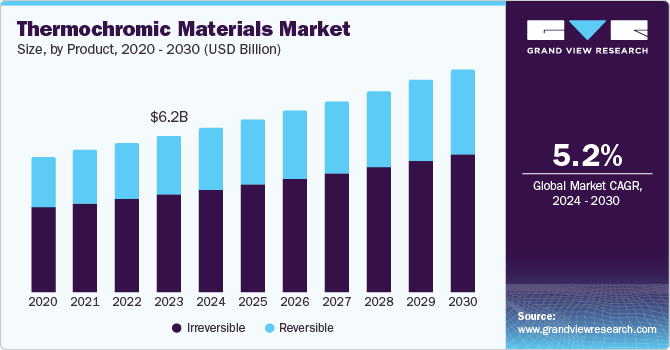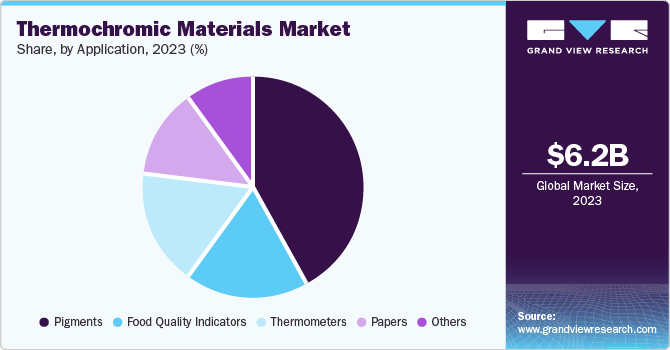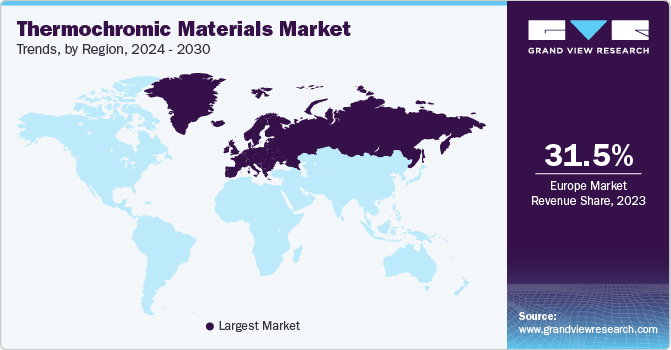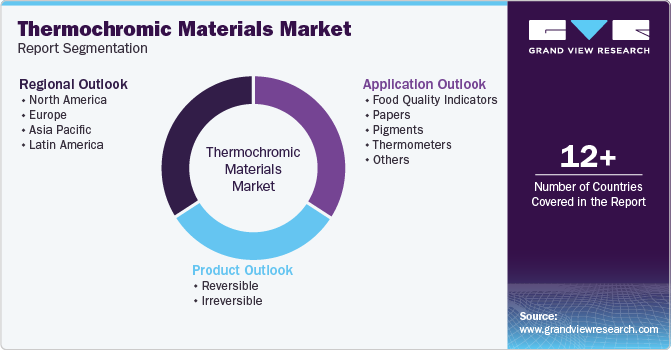
Thermochromic Materials Market Size, Share & Trends Analysis Report By Product (Reversible, Irreversible), By Application (Food Quality Indicators, Papers, Pigments), By Region, And Segment Forecasts, 2024 - 2030
- Report ID: GVR-1-68038-866-4
- Number of Report Pages: 100
- Format: PDF, Horizon Databook
- Historical Range: 2018 - 2022
- Forecast Period: 2024 - 2030
- Industry: Advanced Materials
Thermochromic Materials Market Trends
The global thermochromic materials market size was valued at USD 6.16 billion in 2023 and is projected to grow at a CAGR of 5.2% from 2024 to 2030. This growth is attributed to the increasing demand for smart packaging, particularly in the food and beverage sector, which enhances product visibility and safety. In addition, technological advancements improve the performance and durability of these materials, expanding their applications in consumer electronics and textiles. Furthermore, the rising emphasis on environmental safety encourages using thermochromic materials as indicators for temperature changes, thus promoting their adoption across various industries, including automotive and medical sectors.

Thermochromic materials are innovative substances that exhibit a color change in response to temperature fluctuations. These materials can be formulated as pigments, inks, dyes, or coatings, and they can undergo reversible or irreversible transformations based on specific thermal conditions. These materials have diverse applications across various sectors, including smart packaging that signals product freshness, temperature-sensitive labels for safety and quality assurance, and interactive displays in consumer electronics. Therefore, the global market for thermochromic materials is projected to grow due to their versatile applications and unique properties.
In addition, a significant driver of this market growth is the increasing demand for smart packaging solutions. Companies increasingly adopt advanced technologies, including thermochromic materials, to enhance product differentiation and consumer engagement. Moreover, they are utilized in textiles, automotive components, and various industrial processes to monitor temperature changes effectively. The thermochromic materials market is expected to expand due to applications in the food and beverage sector, where these materials help ensure product authenticity and quality assurance. Furthermore, these materials are important in textiles, healthcare, packaging, security inks, and coatings, as they change color permanently when exposed to specific temperatures. This characteristic makes them ideal for numerous applications in product labeling, security tags, and food packaging.
Moreover, innovations intended to enhance durability, responsiveness, and environmental sustainability are expected to expand their range of applications. The growing trend towards smart technologies, coupled with an increasing demand for interactive and safety features, further drives the integration of thermochromic materials across industries. This growth is driven by continuous product innovations and a rising focus on improvements, making thermochromic materials better and more efficiently applicable with innovative solutions.
Product Insights
Irreversible product segment dominated the market and accounted for the largest revenue share of 62.5% in 2023. Irreversible thermochromic materials are valuable in many applications and are used in medical, packaging, and industrial sectors. These materials exhibit a distinct irreversible transition, typically occurring at elevated temperatures ranging from 60°C to over 400°C, where they change from one color to another (e.g., from violet to white) due to chemical transformations. The significance of these materials lies in their ability to provide permanent visual indicators of temperature exposure, which is significant for ensuring the safety and efficacy of sterilization processes in medical devices and for monitoring overheating in machinery, thereby preventing potential failures. Furthermore, their unique properties and diverse applications across various industries, including security inks and temperature-sensitive packaging, make irreversible thermochromic demanding products in the market.
The reversible segment is estimated to witness substantial growth during the forecast period. Reversible thermochromic materials, which undergo a color change that can be reversed upon cooling, are increasingly in demand across various industries due to their ability to provide real-time temperature response and enhance user experience. For instance, thermochromic inks are utilized in food packaging to signal unsafe temperatures, while smart textiles incorporate these materials to monitor body temperature for comfort. These materials have significant applications in temperature-sensitive devices, smart textiles, food packaging, and energy conservation solutions, where they serve as visual indicators for overheating or temperature fluctuations, further leading to their market growth.
Application Insights
Pigment applications led the market and accounted for the largest revenue share of 42.0% in 2023. Thermochromic pigments are increasingly utilized across various applications, including printing and coatings, textiles and apparel, smart packaging, construction, and military sectors, due to their unique ability to change color in response to temperature variations from opaque to transparent or from colorful to colorless. Moreover, the printing industry utilizes thermochromic pigment in advertising, packaging, and other uses.
The thermochromic pigment is utilized to produce engaging and interactive designs, enhancing the attractiveness of printed materials. The thermochromic pigment is commonly employed in promotional materials like brochures and flyers to make interactive designs that attract customers. These pigments enhance consumer goods, enable exhaustion detection in sportswear, indicate freshness in packaging, and provide energy management solutions in architecture.

Food quality indicators are anticipated to grow significantly over the forecast period. Thermochromic materials serve as effective food quality indicators by providing visual cues regarding the temperature history of perishable products, thereby enhancing food safety and reducing the risk of spoilage. These materials can be classified into reversible and irreversible types; reversible thermochromic pigments change color based on temperature fluctuations, while irreversible pigments permanently indicate when a product has been exposed to unsafe temperatures. This functionality is especially vital in food packaging, where consumers can quickly assess the safety of items without relying solely on smell or texture. Furthermore, the global demand for thermochromic materials as food quality indicators is projected to grow significantly, driven by increasing regulatory requirements for food safety, advancements in packaging technologies, and augmented consumer awareness regarding food quality.
Regional Insights
Europe thermochromic materials market dominated the global market and accounted for the largest revenue share of 31.5% in 2023. Europe has a strong presence of key companies augmented by the rising demand for thermochromic materials in several industries like food packaging, textiles, printings, coatings, etc., which has hugely impacted the high demand for thermochromic materials due to their useful applications.

Germany Thermochromic Materials Market Trends
The thermochromic materials market in Germany is expected to have a major share in the European region, owing to the presence of the leading food & beverage sector; rising awareness and knowledge of such materials among people is likely to fuel the demand for thermochromic materials with consistent growth.
North America Thermochromic Materials Market Trends
The North America thermochromic materials market is expected to experience substantial growth over the forecast period. Thermochromic materials are utilized in general applications in various sectors, such as food and beverage, packaging, textiles, etc. The thermochromic materials market worldwide is compelled by growing demand for smart packaging, advancements in material science, and rising applications of thermochromic materials in the automotive and food industries, mostly in North America, Europe, and the robust escalating Asia Pacific region.
U.S. Thermochromic Materials Market Trends
The thermochromic materials market in the U.S. is a significant market for thermochromic materials. The country's demand for thermochromic materials is expected to grow constantly due to using thermochromic pigments in flexographic and screen-printing inks and the packaging sector. Furthermore, there is an increasing demand for innovative packaging, textiles, and military equipment applications. The use of these materials as food quality indicators and in energy-efficient construction films is gaining traction and contributes to the market's growth.
Asia Pacific Thermochromic Materials Market Trends
The Asia Pacific thermochromic materials market is expected to grow at a CAGR of 5.7% over the forecast period. The region is experiencing robust industrialization and increasing awareness of thermochromic applications in the customer base, fueling the demand for decorative products, textiles, and temperature-sensitive packaging in the food and beverage industry. The flourishing textile and apparel sector influences thermochromic materials for innovative and interactive fabric uses. Increasing investments and the presence of key companies in countries such as China and India boost the implementation of thermochromic materials in different sectors, such as medical devices and pharmaceutical packaging, footwear, smart textiles and apparel, and many more.
China Thermochromic Materials Market Trends
The thermochromic materials market in Chinais driven by rapid industrialization and rising foreign investment, particularly in the automotive and textile sectors. The growing demand for smart packaging solutions and novelty products further fuels market expansion. Furthermore, the increasing use of thermochromic pigments in various applications, including food safety indicators, is enhancing their market presence. The country's focus on innovative materials and technologies supports China's growth trajectory of thermochromic materials.
Key Thermochromic Materials Company Insights
Some of the key companies in the thermochromic materials market include SFXC, Indestructible Paints Limited, H.W. Sands Corp., Fraunhofer IAP, Olikrom, Kolortek Co., Ltd., Shanghai Caison Color Material Chem. Co., Ltd., Thermographics;in the market focusing on the development & creatively introducing newer products with improved quality.
-
SFXC specializes in producing and distributing advanced thermochromic materials, primarily focusing on pigments and inks that change color in response to temperature variations. Their offerings cater to various industries, including packaging, textiles, and consumer goods.
-
H.W. Sands Corp. provides various products such as thermochromic pigments and specialty inks. Their materials are utilized across multiple applications, including packaging, textiles, and industrial coatings. H.W.
Key Thermochromic Materials Companies:
The following are the leading companies in the thermochromic materials market. These companies collectively hold the largest market share and dictate industry trends.
- SFXC
- Indestructible Paints Limited
- H.W. Sands Corp.
- Fraunhofer IAP
- Olikrom
- Kolortek Co., Ltd.
- Shanghai Caison Color Material Chem. Co., Ltd.
- Thermographics
- Smarol Industry Limited.
- NEW PRISMATIC ENTERPRISE CO., LTD.
Thermochromic Materials Market Report Scope
|
Report Attribute |
Details |
|
Market size value in 2024 |
USD 6.47 billion |
|
Revenue forecast in 2030 |
USD 8.78 billion |
|
Growth rate |
CAGR of 5.2% from 2024 to 2030 |
|
Base year for estimation |
2023 |
|
Historical data |
2018 - 2022 |
|
Forecast period |
2024 - 2030 |
|
Quantitative units |
Volume in kilotons, revenue in USD million/billion, and CAGR from 2024 to 2030 |
|
Report coverage |
Revenue forecast, company ranking, competitive landscape, growth factors, and trends |
|
Segments covered |
Product, application, region |
|
Regional scope |
North America; Europe; Asia Pacific; Latin America |
|
Country scope |
U.S.; Canada; Mexico; UK; Germany; France; Italy; Spain; China; India; Japan; Brazil |
|
Key companies profiled |
SFXC; Indestructible Paints Limited; H.W. Sands Corp.; Fraunhofer IAP; Olikrom; Kolortek Co., Ltd.; Shanghai Caison Color Material Chem. Co., Ltd.; Thermographics; Smarol Industry Limited.; NEW PRISMATIC ENTERPRISE CO., LTD. |
|
Customization scope |
Free report customization (equivalent to up to 8 analysts' working days) with purchase. Addition or alteration to country, regional & segment scope. |
|
Pricing and purchase options |
Avail customized purchase options to meet your exact research needs. Explore purchase options |
Global Thermochromic Materials Market Report Segmentation
This report forecasts revenue growth at global, regional, and country levels and analyzes the latest industry trends in each sub-segment from 2018 to 2030. For this study, Grand View Research has segmented the global thermochromic materials market report based on product, application, and region:

-
Product Outlook (Volume, Kilotons; Revenue, USD Million, 2018 - 2030)
-
Reversible
-
Irreversible
-
-
Application Outlook (Volume, Kilotons; Revenue, USD Million, 2018 - 2030)
-
Food quality indicators
-
Papers
-
Pigments
-
Thermometers
-
Others
-
-
Regional Outlook (Volume, Kilotons; Revenue, USD Million, 2018 - 2030)
-
North America
-
U.S.
-
Canada
-
Mexico
-
-
Europe
-
UK
-
Germany
-
France
-
Italy
-
Spain
-
-
Asia Pacific
-
China
-
Japan
-
India
-
-
Latin America
-
Brazil
-
-
We are committed towards customer satisfaction, and quality service.
"The quality of research they have done for us has been excellent."




